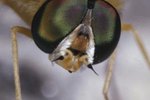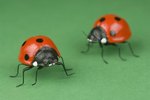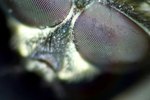
Phototaxis may sound like a disease, but it is a very natural instinct in many types of bugs and insects. You experience its effects when you turn on your front porch light, only to be inundated with a swarm of moths. These moths and other bugs aren't out to get you, they are naturally attracted to light because it mimics daylight, helps them with navigation and alerts them to the presence of food.
Navigation
Many bugs, particularly moths, are nocturnal. Before artificial lights, these bugs evolved to use the stars and moon for navigation in the dark. The light of the moon helps the bugs navigate and fly straight. Artificial lights appear brighter and essentially confuse bugs' navigation systems—driving them straight into the light. Moths, for example, perceive light more brightly in one eye than the other, causing one wing to beat faster—resulting in a confused, circular flight pattern.
Additional Theories
Bugs that are not nocturnal may be attracted to light because it confuses their natural tendency to go dormant in the nighttime. The presence of artificial light fools them into thinking it's still daytime. Light can also fool bugs' procreation instincts. "Penn State News" points out a theory that candle flames mimic the wavelengths of female moth pheromones, drawing in male moths who are looking for love.
Light Colors
Bugs are not automatically attracted to all forms of light. The National Library of Singapore points out that light made up of short wavelengths—particularly blue and violet—is most attractive to insects. Yellow and red lights, however, are less likely to attract bugs. One explanation for this is that flowers naturally reflect ultraviolet light, which makes the blue and violet lights more attractive to bugs who feast on blooms.
Not Universal
Not all bugs and insects are attracted to light at night. Certain types are negatively phototactic and scurry away in the light. Think of how cockroaches flee when you turn on the overhead light. Butterflies are another type of insect that is repelled by artificial light, but has a keen attraction to sunlight.
References
Photo Credits
-
David De Lossy/Photodisc/Getty Images
Writer Bio
Andrea Cespedes is a professionally trained chef who has focused studies in nutrition. With more than 20 years of experience in the fitness industry, she coaches cycling and running and teaches Pilates and yoga. She is an American Council on Exercise-certified personal trainer, RYT-200 and has degrees from Princeton and Columbia University.




